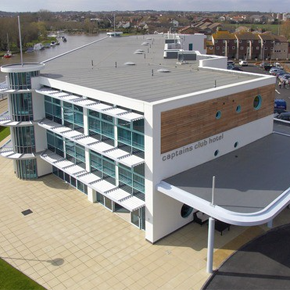
How to choose the right roofing material for your property
It probably isn’t overstating it to say that the roof is the most important part of your property, whether it is a house or a commercial building. It protects the entire property from damage by rain, wind or snow and creates a place to install insulation to make a property more energy efficient.
If it’s time to replace your roof or you are building a new property, then there are lots of styles of roofing material to choose from – but which is best for you?
Every type of material has its own pros and cons. So what is best for a bungalow in the country might not be the same as what is best for a factory in the city. Here we look at the different materials and their benefits to help you decide.
Clay Tiles
Clay tiles are available in a wide range of shapes and colours and often with special tiles for areas such as gulleys and valleys. They have a very long lifespan with one example being the Guildhall in Lincoln that was found to have clay tiles from the 14th century! But the weather can take a toll on them, especially with the increase in rainfall we now see. The constant cycle of wet then freezing conditions can lead to cracks though there is a frost requirement standard for clay tiles in the UK.
Stone
Stone is one of the most expensive materials for a roof but it is often used in conservation areas and on listed buildings. Stone can be made into thicker tiles that are good on properties with a steeper pitch, usually at least 45 degrees. They do require specialist fitting and use stone nails but are extremely durable and have a great lifespan.
Slate
Another popular roofing material, slate works on houses with a 30 degree roof pitch and comes in a wide range of colours including those from outside the UK such as from Canada, China and Spain. Recycled slate is a way to get the same look while reducing the cost and is usually mixed with concrete to create the look while reducing the cost.
Concrete
Manmade concrete tiles have come to the top of the list in recent decades for their variety, ease of use and economy. There are plenty of different styles and their interlocking form means they are very waterproof. There are also lots of different colours to match with the property or the area. Sometimes these tiles can weather differently, creating an uneven look and they don’t have the lifespan of the natural materials.
Metal
Metals have been used in roofing systems for hundreds of years – architects in the Elizabethan times used lead on their roofs while the use of cooper to create complicated domes and other styles is well known. Metal is easy to make into a variety of shapes and styles and can be laid onto shallow pitches unlike some materials. It is very long lasting but there is a trend towards stealing it for its re-sale value.
Author: Stuart Cooke – Marketing Manager at SpecifiedBy, Edinburgh
Latest news

19th April 2024
ASSA ABLOY: Access solutions can impact sustainability performance across the full life-cycle of a building
Embedding sustainability within any organisation requires a broad, strategic perspective. Scrutiny should include the physical infrastructure itself: According to the IEA, buildings consume around 30% of global energy*. ASSA ABLOY has more…
Posted in Access Control & Door Entry Systems, Architectural Ironmongery, Articles, Building Industry News, Building Products & Structures, Building Regulations & Accreditations, Building Services, Case Studies, Doors, Facility Management & Building Services, Information Technology, Research & Materials Testing, Retrofit & Renovation, Security and Fire Protection, Sustainability & Energy Efficiency, Video of the Week
19th April 2024
British weather doesn't dampen spirit for new HMG Garden Paint
Despite one of the wettest starts to the year on record, customers are starting to plan for brighter days with HydroPro Garden Paint from HMG Paints.
Posted in Articles, Building Industry News, Building Products & Structures, Garden, Innovations & New Products, Paints, Paints, Coatings & Finishes, Restoration & Refurbishment, Retrofit & Renovation, Site Preparation, Sustainability & Energy Efficiency, Waste Management & Recycling
18th April 2024
Abloy UK showcases new digital portfolio at The Security Event 2024
Abloy UK is set to unveil its latest line-up of access control systems at The Security Event 2024, welcoming guests to explore its cutting-edge electromechanical and digital solutions on stand 5/F50.
Posted in Access Control & Door Entry Systems, Architectural Ironmongery, Articles, Building Industry Events, Building Industry News, Building Products & Structures, Building Services, Doors, Exhibitions and Conferences, Facility Management & Building Services, Health & Safety, Information Technology, Retrofit & Renovation, Security and Fire Protection
18th April 2024
Strand is a Failsafe Choice for Emergency Exit and Panic Hardware
In times of emergency, you’re in safe hands with Strand Hardware. Although there are many considerations for building specification, few decisions can be as critical as selecting the right emergency exit/panic hardware.
Posted in Access Control & Door Entry Systems, Architectural Ironmongery, Articles, Building Industry News, Building Products & Structures, Building Services, Doors, Facility Management & Building Services, Health & Safety, Restoration & Refurbishment, Retrofit & Renovation, Security and Fire Protection
 Sign up:
Sign up: